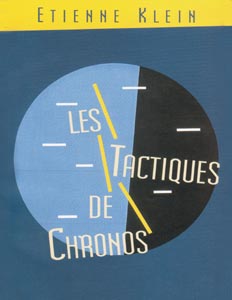by Etienne Klein, Editions Flammarion. ISBN 208210091X, €18.00.

Time is an elusive concept and presents itself in manifold and disparate guises. As a result, dictionaries mention it in relation to fields as varied as choreography, economics, horse-riding, linguistics, liturgy, seafaring, sports, forestry, hunting and, obviously, physics. In his book Les tactiques de Chronos (Chronos’s tactics), Etienne Klein sheds some light on the ideas each of us have of the disconcerting parameter that is time.
With his considerable store of philosophical and scientific knowledge, the author sets out to help the reader understand the concept of time. However, the meaning of time remains ambiguous and the book warns of the difficulties in providing a definition. The reader is reminded of the words of Saint Augustine: “What, then, is time? If no one asks me, I know what it is. If I wish to explain it to him who asks, I do not know.”
Klein attempts to assist Saint Augustine. He begins with a summary of the various philosophies put forward over the ages, before introducing the concept of physical time with Galileo, who included time as a variable in dynamic equations. The concept of time was revolutionized by relativity theory and lost its absolute quality. Quantum mechanics suggests that going back in time is like crossing over into the world of antimatter. Klein goes on to discuss the “arrow” of time, which stipulates the irreversibility of macroscopic phenomena, and is illustrated by effects such as entropy and the evolution towards more probable states. This brings him to a discussion of CP violation, which implies T violation, in microscopic phenomena. The author does not shy away even from the most speculative of concepts, such as discontinuous time or time with several dimensions as a possible consequence of superstring theory. On the anecdotal side, the reader learns who wrote the article on time in Diderot and d’Alembert’s encyclopaedia. It was J J Rousseau. We also find out to whom the phrase “eternity is long, especially towards the end” can be attributed – a list that over the years has included Franz Kafka, French humorist Pierre Dac and Woody Allen – and about S B Preuss, the physicist who put his name to just one article, albeit alongside Albert Einstein’s.
While reading the book, which is a pleasure, it becomes clear that physics has made an important contribution to our understanding of time. It also becomes evident that a subjective time exists that is distinct from physical time, or if you prefer an individual time that is superimposed on universal time. Is not subjective time evidence of our relationship to physical time? This question is addressed in the final chapter of the book, entitled “Has physics forgotten about death?”. Life still transcends the laws of physics, and it may be that man’s concept of time is defined by his awareness of his own mortality. This hypothesis remains unanswered and the book is rounded off with a comprehensive bibliography of the sources used by the author.
Having finished the book, the physicist is left with the feeling of being closer to the philosopher, and maybe the philosopher will be better able to understand the need to take into account the major advances in physics in order to provide a more complete picture of the human experience.







